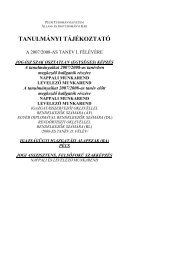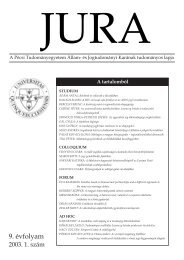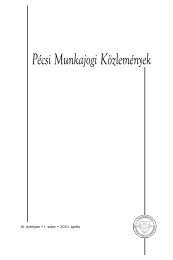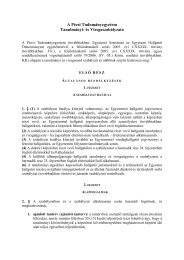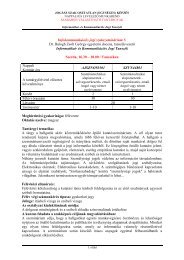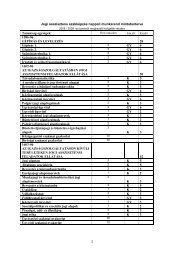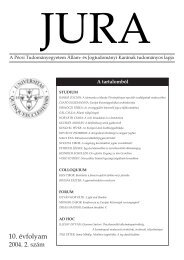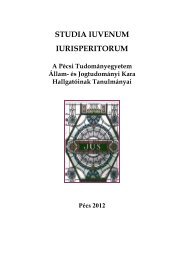2012. évi 2. szám - Jura - Pécsi Tudományegyetem
2012. évi 2. szám - Jura - Pécsi Tudományegyetem
2012. évi 2. szám - Jura - Pécsi Tudományegyetem
- TAGS
- jura
You also want an ePaper? Increase the reach of your titles
YUMPU automatically turns print PDFs into web optimized ePapers that Google loves.
Andityas Soares de Moura Costa Matos: An alternative approach to the basic norm …147PAULSON, Stanley L. Introduction. In: PAULSON,Stanley L.; PAULSON, Bonnie Litschewski (orgs.). Normativityand norms: critical perspectives on kelsenian themes. Trads.Bonnie Litschewski, Stanley L. Paulson and Michael Sherberg.New York: Oxford/Clarendon Press, pp. xxiii-liii, 2007.PAULSON, Stanley L. Kelsen and the Marburg school:reconstructive and historical perspectives. In: KRAWIETZ,Werner (org.). Prescriptive formality and normative rationality inmodern legal systems: Festschrift for Robert Summers. Berlin:Duncker & Humblot, pp. 481-494, 1994RAZ, Joseph. Kelsen’s theory of the basic norm. In:PAULSON, Stanley L.; PAULSON, Bonnie Litschewski (orgs.).Normativity and norms. New York: Oxford/Clarendon Press,pp. 47-67, 2007RENAUT, Alain. Kelsen et le problème de l’autonomiedu droit. In: Cahiers de philosophie politique et juridique del’université de Caen, n. 9, pp. 7-21, 1986ROY, Louis. Pour une interprétation large de la normefondamentale-transcendantale de Hans Kelsen. In: Cahiersd’épistémologie, n. 238, 1997SOSOË, Lucas. La distinction de l’être et du devoir-êtredans la théorie pure du droit. In: Cahier de philosophie politiqueet juridique de l’Université de Caen, n. 9, pp. 65-81, 1986TREVES, Renato. Un inédit de Kelsen concernant sessources kantiennes. Trad. Michel Troper. In: Droit e societé, n.7, pp. 327-335, 1987TROPER, Michel, 1978. La pyramide est toujours debout!Réponse à Paul Amselek. In: Revue du droit public et de la sciencepolitique en France et à l’étranger, t. 94, n. 6, pp. 89-103, 1978VAIHINGER, Hans. The philosophy of “as if”: a system ofthe theorethical, pratical, and religious fictions of mankind.Trad. C. K. Ogden. London: Routledge and Kegan Paul, 2002WRIGHT, Georg Henrik von. Is and ought. In: PAUL-SON, Stanley L.; PAULSON, Bonnie Litschewski (orgs.).Normativity and norms. New York: Oxford/Clarendon Press,pp. 365-382, 2007Notes1“Having determined the province of jurisprudence, Ishall distinguish general jurisprudence, or the philosophy ofpositive law, from what may be styled particular jurisprudence,or the science of particular law; that is to say, the scienceof any such system of positive law as now actually obtains, oronce actually obtained, in a specifically determined nation, orspecifically determined nations” (Austin 2003, iii).2To read the text of the letter in French, the first publishedsince it was written in 1933, see Treves 1987, 333-335. Thedocument was translated into English and published in Kelsen2007b, 169-175. The original in German and a Italian translation(by Agostino Carrino) are available in Kelsen; Treves 1992, 55-58; 51-54, respectively. For an analysis of the letter, Matos 2006,66-68. The knowledge and study of the missive is importantto avoid anachronistic interpretations according to which thefinal characterization of Kelsen’s basic norm would be a legalfiction, mistake committed by José Florentino Duarte in hisintroduction to Kelsen 1986, VIII – IX. Paulson, who knows theletter very well, prefers to credit the skeptical phase of Kelsenthe supposed change of direction with regard to the natureof the basic norm. See Kelsen 2007b, 174, n. 15. The topic isdiscussed at leisure in subsection 3.1. of this paper.3According to Paulson, Kelsen’s work can be dividedinto three phases. The first, called “critical constructivism”would occur between 1911 and 1921, covering a period oftransition from 1913 to 1921. The second phase – called “classical”– would include most of the work of Kelsen, coveringthe years 1921 to 1960 and showing two distinct periods: theneo-Kantian (1921 to 1935) and the hybrid (1935 to 1960),which combined analytical elements to the neo-Kantian viewsalready settled. Finally, the third and final phase would be the“skeptical”, that would go from 1960 until the death of Kelsenin 1973 (Paulson 2007, xxvii).4Contrarily to the tradition, Paulson affirms that Kelsen’sneo-kantian legacy must be searched in Heidelberg, not inthe Marburg School, which is guided by Cohen. See Paulson1994, 485-494.5So, as an object of the legal cognition, the State can onlybe conceived in legal terms, because juridically knowing somethingmeans to know as Law. See Kelsen 2007a, 15-16.6To a analisys of the matter, see Goyard-Fabre 2002, 345;Matos 2006, 31-37; Roy 19977A debate about the differences between the basic normsthat are present in the static legal systems (natural law) andthe dynamic ones (legal positivists) can be found in the essay“The doctrine of natural law and legal positivism” in Kelsen2000, 557-580.8The proposition that describes the basic norm is ahypothetical judgment capable of, when assumed the Grundnorm– “if” it’s assumed, because it is a hypothesis –, enablingthe interpretation of certain norms as legal. However, I mustregister the position of Celano 2000, 184, who believes that thebackground question – is the basic norm an expression of thehypothetical or the categorical judgments? – is obscure andunstable, what makes this author believe that the basic normembodies a categorical judgment, because the legal cognitionsees it as something unspoken.9Hammer asserts that the assumption of Kelsen’s basicnorm isn’t a simple subjective decision about wanting or notseeing the law as a science. Actually, it’s about an epistemologicalnecessity for any strictly legal interpretation of normativematerials. See Hammer 2007, 186-188.10See Losano’s introductory study in Kelsen 1998a.11The expression “closure norm” as synonym to the basicnorm was coined by Bobbio in a interview given by DaniloZolo. See Bobbio; Zolo, 1998.12Raz rightly criticizes the first of these propositions inRaz 2007, 51-53. To do so, he resorts to an internationalistargument originally made by H. L. A. Hart.13As wrongly suggested by Edel 2007, 216 – who believedthat the basic norm is a reflection of a “logical endpoint” – andRoy 1997, 11.14Our interpretation is approved by Bobbio: “Kelsen’sclosure of the legal order is a sort of reference back from finalcauses to the first cause, from empirical determinations to thecausa sui. Thus in an essentially non-metaphysical thinker likeKelsen the ‘closure’ of a system through the Grundnorm is only,so to speak, a closure of convenience. It is a little like the ideaof the absolute sovereignty of the nation-state. The idea ofsovereignty as ‘power of powers’ is a closure of convenience,no different from the Grundnorm conceived of as a ‘norm ofnorms’” (Bobbio 1998, 2-3).JURA 2012/<strong>2.</strong>



